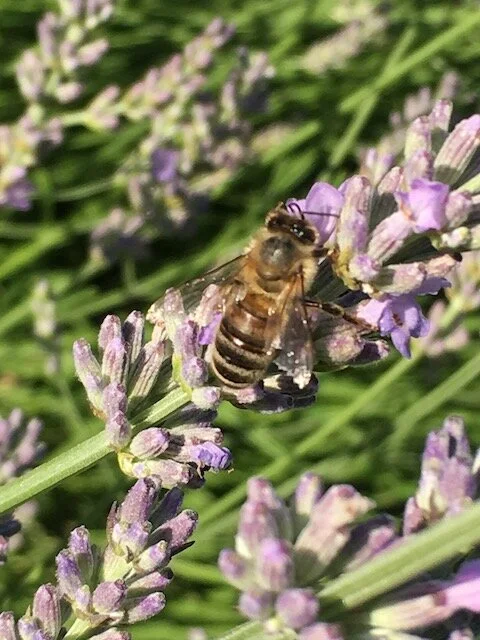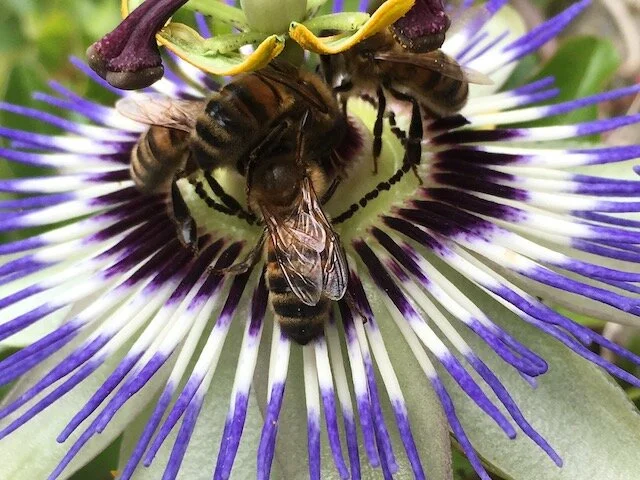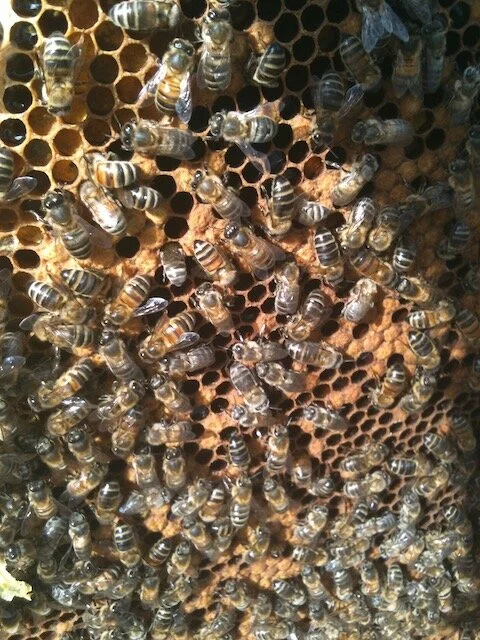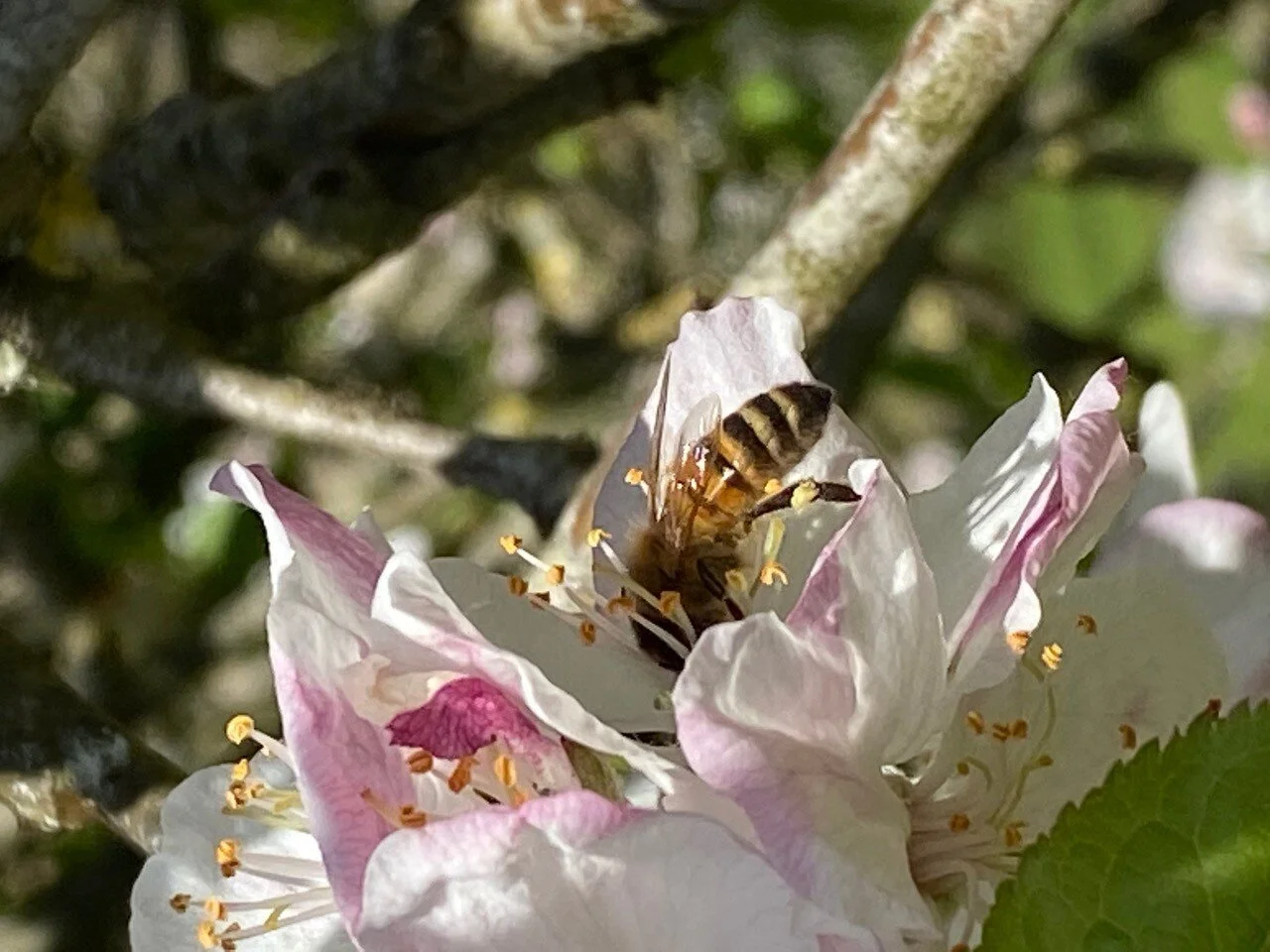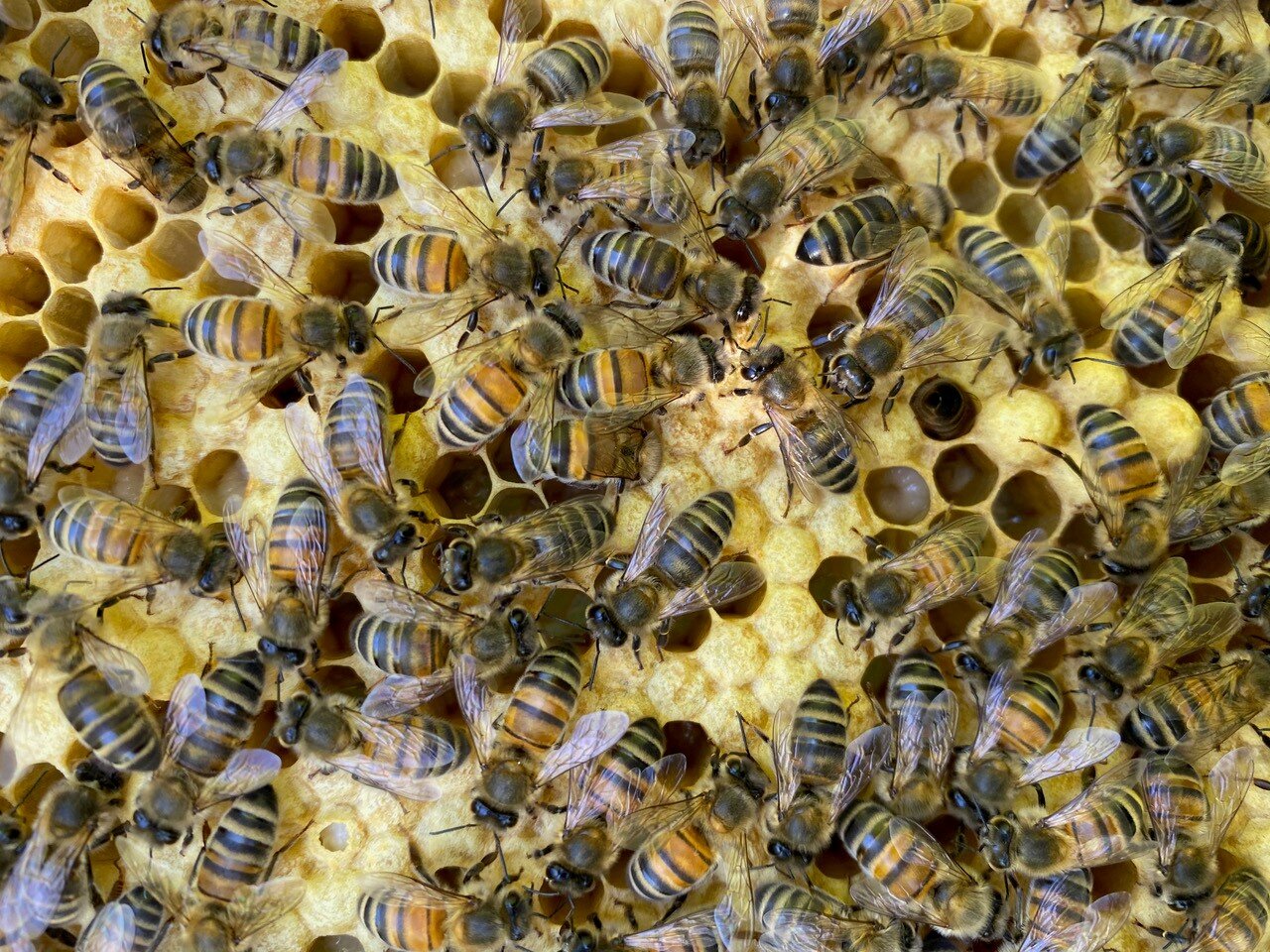The Secret Life of Bees in Chiselborough
by Neil Cook

Spring Awakening
I was born again today. I vaguely remember being born the first time, and my (short) life as a larva; it was mainly eating bee bread (a very tasty mix of pollen and honey) and growing a lot. Then I remember feeling very sleepy, and when I woke up, I felt very different – 8 days ago I was a plump white caterpillar, and now I am a highly evolved social insect – one of the wonders of the insect world, even if I do say so myself!
After waking, I saw in front of me the wax capping of my cell, which I quickly nibbled through, and I emerged into my new home. It really was a hive of activity (sorry I promise no more bee puns!), with nurse bees rushing around everywhere feeding larvae, and all around me other new bees were also emerging. There must have been hundreds, or even thousands of us all coming out together. I found out later that our mother, the Queen, can lay up to 1500 eggs per day, particularly at this time of year – that’s more than her own body weight. She doesn’t have time to feed herself, so all of us worker bees have to keep her fed as she wanders around the colony.
I’m one of around 30,000 worker bees in our colony; there will be even more by the summer – around 50-60,000, so it might get quite crowded in here. All of us workers are female – there are some male bees called drones, but they just sit around the colony all day eating the food we workers bring in, and sometime venturing out to find a queen to mate with. I hear human males are quite similar!
Well I can’t really stop to chat for too long, I’ve just found out my jobs for the next 2-3 weeks, and I’m going to be really busy feeding larvae, cleaning out the brood cells, storing the nectar that the foragers bring in, making new honeycomb, and generally keeping everything shipshape. Actually nobody told me to do all that, it just comes naturally – amazing eh? If I get time I’ll catch up with you in a month or so at the start of summer.
In the meantime, if you want to know where I live, it’s just above the north porch of Chiselborough Church – come by and give me a wave sometime… I’ll ask my sisters to refrain from stinging you (only joking – we’re very friendly!)
Summer Nights
Well it’s certainly been a busy month since we last spoke. I mentioned that it might get crowded; well it certainly did – we were thorax-by-wing in here for a while. And with the good weather (so I heard – I never got to go outside unfortunately), the foragers were bringing in nectar like there was no tomorrow! We tried to build enough comb to store it all, but we just ran out of space to put it all. On top of that, because there were so many of us, it started to get harder and harder to smell (I’m using the human word here – there’s no direct translation from honeybee) the queen’s pheromones. This makes everyone unhappy, and the end result was that the colony decided to swarm!
I was really excited about this until I realised that as a house bee, I’d be left behind – only the foragers and the queen get to swarm... Still it did mean that I had a big hand in helping with the preparations. Firstly we created lots of queen cups for the queen to lay eggs in – these are different from normal honeycomb cells, and look a bit like thimbles. Then after the queen had laid eggs in them, and they hatched into larvae, we starting feeding them like crazy, with a specially rich food called Royal Jelly, which turns normal worker larvae into queens. Queens grow much faster than normal bees, and are also much bigger, which is why we have to make the special cells for them. Then we started putting the queen on a diet, because she’s actually going to have to fly when the colony swarms – something she hasn’t done since her mating flights a couple of years ago. I hope she remembers how to do it!
After a week, everything was ready – the first queen cell had been sealed with wax, ready for a new queen to pupate, and the swarm was off! Well actually not, because it was raining (did you know us bees have far more reason to complain about the British weather than you humans!), and swarming is no fun at all in the rain. Thankfully the next day was bright and sunny, so after gorging on our excess honey to keep them going for a few days, all the foragers (around 20,000 of them) and the queen left around lunchtime, off to find a new home. All very exciting, and I must admit to feeling a little glum and lonely, with so few bees around the colony. Still, I had something to look forward to – I was finally ready to become a forager!
I wrote that yesterday. I can’t believe how excited I was; if I’d realised just how much work foraging is, I might have been less enthusiastic! My job is to wait around near the entrance to the colony, greeting the scout bees as they come in with nectar. They give me some to taste, and then they do a special dance (humans call it the waggle dance) to show me and the other foragers where to find it. If we like the taste (more sugar is better!), then we fly off to find the flowers it came from. We use the sun to navigate (even when it’s cloudy) – the waggle dance tells us how to do that, as well as how far to go – a bit like a human sat-nav, but without the annoying voice telling you to turn around at the next opportunity! It was great fun at first, but soon I realised that flying up to 2 miles or more (that’s as far as the blackcurrant fields near Stoke) for a few drops of nectar is blooming hard work! Especially if there’s a strong wind… and if the nectar’s too far away, I use most of it just to get home. Sadly, the blossom closest to us in the apple orchard behind the church has all gone, so I spent the whole day collecting lavender nectar, which luckily is in plentiful supply round here, as there are lots of keen gardeners in Chiselborough, with bee-friendly planting schemes. If you are wondering how to help me and my sisters, just make sure you plant lots of different types of flowering plants – the more variety, the better. Don’t forget we collect pollen as well as nectar – even the humble hazel catkin is a great source of pollen for feeding our young.
Well, I’m far too tired to chat anymore, I’m off for a well-deserved rest; hopefully we’ll speak again soon!
Season of Mists and Mellow Fruitfulness
Hello again it’s your friendly neighbourhood honeybee here, reporting again from the North Porch of Chiselborough Church. Well technically speaking I’m not the same bee each time, because we bees don’t live very long in general. In the summer my fellow workers will live about 6 weeks or so, working until they literally drop, usually out in the fields, collecting nectar or pollen. I know as humans you’re probably anthropomorphising us, and thinking that’s terrible, but you have to remember that the life of an individual bee is subservient to the needs of the colony - we live and die as a group and the needs of the many outweigh the needs of the few (something I think you humans could learn a lesson from). I was born in what you would call early autumn, and my main job will be firstly raising the bees that will overwinter, and after that collecting any of the late nectar and pollen that's available, especially from plants like ivy and himalayan balsam. The winter bees will live much longer - right through to the spring, ready to help rear the first crop of youngsters as the weather gets warmer and the sun gets higher in the sky. You might think I’d be sad that I won’t get to live as long as them, but remember I’m helping the colony to survive and that’s what’s important to me. It’s best to think if a colony of bees like ours as a single organism - that’s why swarming is so important to us - it’s our way of reproducing. You humans might think it’s quite annoying when 20 thousand bees land in a tree in your garden, but next time you see a swarm, think of it as a new colony of bees being born, and maybe you’ll change your perspective!
The sun is definitely getting lower in the sky now, and the nights are drawing in, but on a fine day you’ll still see lots of us out and about collecting pollen (particularly important for raising winter bees - we feed them extra pollen to make them nice and fat for the long winter nights), nectar and even water (we use water to dilute the honey that we’ve stored - having a water source is really important to us in the winter, when we gradually consume the honey we collected in the summer). You may be wondering how we find out way around, and since you asked, I’ll tell you. Some people know that we use the sun to navigate, which is true, but have you ever wondered how we find our way on a cloudy day? It turns out we bees can see the pattern of polarised light that is created by the scattering of sunlight off particles in our atmosphere, (think of our eyes like really good sunglasses!), and we use that pattern to determine where the sun is, and thus where to fly. But, I hear you cry, how do you know where to fly to in the first place? How do we know where the flowers are? Well, we have lots of scout bees who go out and find nectar, pollen and water. They come back to the hive, and they tell us where those food sources are by performing what you humans call a “waggle dance” (we have a much better, cooler name for it, but I can’t tell you or I’d have to sting you! (Only joking…) The waggle dance tells us how far the food source us, and what angle to the sun we need to fly to get there. It might seem complicated, but it’s just natural to us.
Right, enough chat, I’m off to see if that lovely patch of ivy I found yesterday is still in flower, bye for now!
Winter Wonderland
Welcome back, although I am finding talking a bit tricky, because it’s so c-c-cold! Only joking, it’s actually toasty warm in here! I’m currently right in the middle of our winter cluster, where we all huddle together to stay warm. We actually keep the centre of the hive a constant temperature right through the winter (32-35 degrees Celsius), because, even though our queen slows her rate of lay right down, there’s usually a small amount of brood, even in the depths of winter, which we have to keep warm. Imagine one of those David Attenborough documentaries about penguins, except we’re a three-dimensional ball, not a 2D circle. Even do the same trick as penguins - we all spend a bit of time on the outside where it’s coldest, before gradually moving into the middle, and then back out again. Remember, we act as a colony, not individuals, and behaving like this means we can survive even the coldest winters (I heard there are honey bees in a place called Canada where it gets down to -40 degrees C in the winter!). We keep warm by shivering our wings, which generates heat. Of course it also means we’re using energy, so we have to keep eating our stored honey to keep our energy levels up (I think my colleague mentioned that we need to get water to dilute it, which means you’ll see us bees outside even in the winter if the days not *too* cold). We also go outside occasionally in the winter to, ahem, perform our ablutions, as it were (although pretty infrequently compared to you humans).
Apart from that, i.e. shivering and eating, there’s not a lot to do in the winter. So we all spend our time thinking about the upcoming Spring, about first crocus flower we’ll find (crocuses are great for pollen), the first fruit blossom (often a pear tree), and of course visiting the beautiful countryside around Chiselborough. I can’t wait - maybe I’ll see you around on a sunny March afternoon - feel free to give me a wave (and if you feel like planting more crocuses, be my guest!)
Bee on Apple Blossom - Neil Cook
Honey Bees looking after their young - Neil Cook
All photography by Neil Cook
